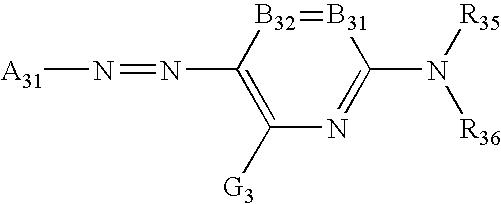Ink and Ink Set for Inkjet Recording
a technology of inkjet recording and composition, which is applied in the direction of inks, duplicating/marking methods, printing, etc., can solve the problems of dyes and pigments, no one knows colorants that satisfy all the requirements, and it is difficult to seek colorants, etc., to achieve good inkjet stability, good absorption characteristics, and flat spectrum
- Summary
- Abstract
- Description
- Claims
- Application Information
AI Technical Summary
Benefits of technology
Problems solved by technology
Method used
Image
Examples
example 1
[0514] Ultrapure water (resistance, at least 18 MΩ) was added to the components shown below to make one liter, and then stirred under heat at 30 to 40° C. for 1 hour. Next, the resulting mixture was filtered under reduced pressure through a micro-filter having a mean pore size of 0.25 μm, to prepare an yellow ink, Y-101.
[0515] (Formulation of Yellow Ink, Y-101)
(Solid Components)Yellow Dye (DYE-83)50g / literProxel5g / literUrea25g / liter(Liquid Components)Triethylene Glycol Monobutyl Ether (TGB)100g / literGlycerin (GR)115g / literTriethylene Glycol (TEG)100g / liter2-Pyrrolidone35g / literTriethanolamine (TEA)8g / literSurfynol STG (SW)10g / liter
[0516] The yellow dye (DYE-83) used herein had an oxidation potential of 1.23 V (vs SCE), measured in a cyclic voltammetry (CV) method and a rotary ring disc electrode method of analyzing an aqueous solution of the dye (1 mmol / liter).
[0517] For comparison, an yellow ink cartridge, Epson's PM-980 was used.
[0518] Other yellow inks shown in the Table bel...
example 2
[0535] Ultrapure water (resistance, at least 18 MΩ) was added to the components shown below to make one liter, and then stirred under heat at 30 to 40° C. for 1 hour. Next, the resulting mixture was filtered under reduced pressure through a micro-filter having a mean pore size of 0.25 μm, to prepare an yellow ink, Y-201.
[0536] (Formulation of Yellow Ink, Y-201)
(Solid Components)Yellow Dye of the invention (DYE-83)30g / literProxel5g / literUrea20g / liter(Liquid Components)Triethylene Glycol Monobutyl Ether (TGB)60g / literGlycerin (GR)100g / literTriethylene Glycol (TEG)40g / literIsopropanol40g / liter1,5-Pentanediol40g / literTriethanolamine (TEA)8g / literSurfynol STG (SW)10g / liter
[0537] Other yellow inks shown in the Table below were prepared in the same manner as that for the yellow ink Y-201, for which, however, the dye indicated below was used in place of the dye, DYE-83.
TABLE 6No.Yellow DyePM-950C (comparison)—Y-201 (comparison)DYE-83 (30 g / liter)Y-202 (comparison)C (33 g / liter)Y-203 (c...
example 3
[0543] Ultrapure water (resistance, at least 18 MΩ) was added to the components shown below to make one liter, and then stirred under heat at 30 to 40° C. for 1 hour. Next, the resulting mixture was filtered under reduced pressure through a micro-filter having a mean pore size of 0.25 μm. Inks of different colors were thus prepared.
[0544] (Formulation of Light Cyan Ink)
(Solid Components)Cyan Dye (C-1) 20 g / literUrea (UR) 15 g / literBenzotriazole (BTZ)0.08 g / literProxel XL2 (PXL 3.5 g / liter(Liquid Components)Triethylene Glycol (TEG) 110 g / literGlycerin (GR) 130 g / literTriethylene Glycol Monobutyl Ether (TGB) 110 g / liter2-Pyrrolidone (PRD) 60 g / literTriethanolamine (TEA) 7 g / literSurfynol STG (SW) 10 g / literCyan Dye (C-1):
[0545] (Formulation of Cyan Ink)
(Solid Components)Cyan Dye (C-1)60g / literUrea (UR)30g / literBenzotriazole (BTZ)0.08g / literProxel XL2 (PXL)3.5g / liter(Liquid Components)Triethylene Glycol (TEG)110g / literGlycerin (GR)130g / literTriethylene Glycol Monobutyl Ether ...
PUM
| Property | Measurement | Unit |
|---|---|---|
| weight % | aaaaa | aaaaa |
| length | aaaaa | aaaaa |
| length | aaaaa | aaaaa |
Abstract
Description
Claims
Application Information
 Login to View More
Login to View More - R&D
- Intellectual Property
- Life Sciences
- Materials
- Tech Scout
- Unparalleled Data Quality
- Higher Quality Content
- 60% Fewer Hallucinations
Browse by: Latest US Patents, China's latest patents, Technical Efficacy Thesaurus, Application Domain, Technology Topic, Popular Technical Reports.
© 2025 PatSnap. All rights reserved.Legal|Privacy policy|Modern Slavery Act Transparency Statement|Sitemap|About US| Contact US: help@patsnap.com



